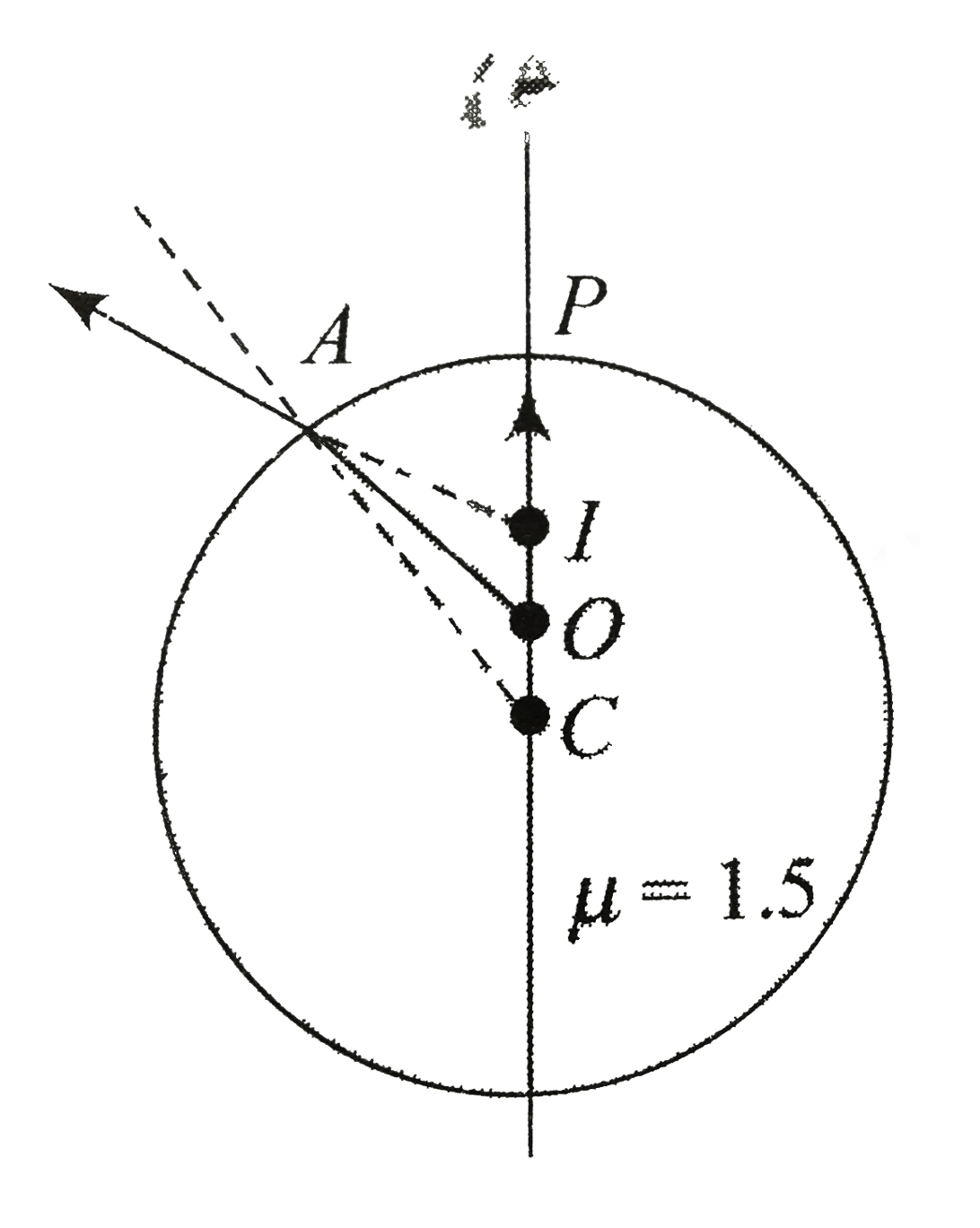There is a small air bubble at the centre of a solid glass sphere of radius r and refractive index μ . What will be the apparent distance of the bubble from the centre of the sphere, when viewed from outside? Solution in Bengali
r
rμ
r(1−1μ)
zero
The correct Answer is:D
Since the air bubble is present at the centre of the solid glass sphere, light rays coming from the air bubble is incident normally on the surface of the sphere. Therefore no deviation of light rays occurs in this case. So the air bubble is seen at its original position.
Topper's Solved these Questions
- BOOK - CHHAYA PUBLICATIONCHAPTER - REFRACTION OF LIGHTEXERCISE - JEE MAIN2videos
REFRACTION OF LIGHT
- BOOK - CHHAYA PUBLICATIONCHAPTER - REFRACTION OF LIGHTEXERCISE - AIMPT2videos
REFRACTION OF LIGHT
- BOOK - CHHAYA PUBLICATIONCHAPTER - REFRACTION OF LIGHTEXERCISE - EXAMINATION ARCHIVE WITH QUESTION8videos
REFRACTION OF LIGHT
- BOOK - CHHAYA PUBLICATIONCHAPTER - REFLECTION OF LIGHTEXERCISE - INTEGER ANSWER TYPE3videos
REFLECTION OF LIGHT
- BOOK - CHHAYA PUBLICATIONCHAPTER - SEMICONDUCTORS AND ELECTRONICS EXERCISE - CBSE SCANNER31videos
SEMICONDUCTORS AND ELECTRONICS
Similar Questions
Monochromatic light is incident on a glass prism of angle A. If the refractive index of the material of the prism is μ , a ray, incident at an angle θ , on the face PQ would get transmitted through the face PR of the prism provided.
 01:58View Solution
01:58View SolutionThe angle of a prism is A. One of its refracting surfaces is silvered. Light rays falling at an angle of incidence 2A on the first surface returns back through the same path after suffering reflection at the silvered surface. The refractive index μ , of the prism is
 02:50View Solution
02:50View SolutionThe refracting angle of an equilateral prism is A. Derive an expression for the angle of deviation for a ray of light incident on the refracting surface of the prism. Draw a neat curve to show the variation of deviation with angle of incidence of the incident ray.
01:19View SolutionThe image of an object placed at a distance of 40 cm from a convex mirror is formed at a distance of 10 cm from the mirror. If object approaches the mirror with a velocity of 32cm⋅s−1 , what will be the velocity of the image (incm⋅s−1)
04:59View Solution(a) Describe briefly with the help of a diagram the role of the two important processes involved in the formation of a p-n junction.
05:03View SolutionThere is a small air bubble inside a glass sphere (μ=1.5) of radius 10 cm. The bubble is 4.0cm below the surface and is viewd normally from the outside. Find the apparent dipth of the bubble.
 View Solution
View SolutionFig shows a small air bubble inside a glass sphere (μ=1.5) of radius 10 cm. the bubble is 4.0 cm below the surface and is viewed normally from the outside. Find the apparent depth of the bubble.
 03:15View Solution
03:15View SolutionThere is a small air bubble at the centre of a solid glass sphere of radius 'r' and refractive index mu . What wil be the apparent distance of the bubble from the centre of the sphere, when viewed from outside?
View SolutionAn air bubble is situated at a distance of 0.08 m from the centre of a sphere of radius 0.12 m. When viewed from the nearest side it appears to be distance of 0.09 m from the centre. Find the refractive index of the material of the sphere. Where will the bubble appear to be when viewed from the farther side?
View SolutionA glass sphere (μ =1.5) of radius 20 cm has small air bubble 4 cm below its centre. The sphere is viewed from outside and along vertical line through the bubble. The apparent depth of the bubble below the surface of sphere is (in cm)
02:24View SolutionA glass sphere (mu=1.5) of radius 20 cm has a small air bubble 4 cm below its centre. The sphere is viewed from outside and along a vertical line through the bubble. The apparent depth of the bubble below the surface of sphere is (in cm)
03:30View SolutionThere is a small air bubble inside a glass sphere (μ=1.5) of radius 10 cm. The bubble is 4 cm below the surface and is viewed normally from the outside. The apparent depth of the bubble is
02:21View SolutionA glass sphere of radius 20cm has a small air bubble 4cm below its centre. The sphere is viewed from outside and along a vertical line through the bubble. The apparent depth of the bubble below the surface of sphere is
View SolutionThere is a small air bubble inside a glass sphere of radius 10cm. The bubble is 4cm below the surface and is viewed normally from the outside. The apparent depth of the bubble is
View SolutionA sphere made of transparent material of refractive index ( mu =3/2 )and of radius 50 cm has a small air bubble 10 cm below the surface. The apparent depth of the bubble if viewed from outside normally is
03:22View Solution

